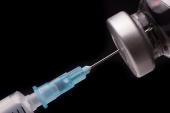Patch-Pump Delivery of Subcutaneous Furosemide Opens Options in HF
A reformulated concentration of the diuretic delivered subcutaneously could be “game-changing,” early trials hint.

MADRID, Spain—A novel patch-pump capable of delivering subcutaneous furosemide over a 5-hour period results in similar bioavailability and efficacy as an intravenous infusion and is well tolerated by patients, two phase I feasibility trials suggest.
The successful pilot trials have paved the way for a larger, randomized, multicenter trial in the United Kingdom to investigate whether use of the furosemide patch-pumps at home could safely allow earlier discharge from the hospital, said Joanna Osmanska, MBChB (University of Glasgow, Scotland), who presented the findings here at the European Society of Cardiology Heart Failure (ESC-HF) 2022 congress.
The ability to safely and effectively deliver loop diuretics subcutaneously would enable parenteral administration in other settings such as hospice or home, said Osmanska. Conventional preparations of furosemide are used off-label in the hospital for subcutaneous infusions when patients are hospitalized with acute congestion, she explained to TCTMD. But because of its alkalinity and low concentration (requiring high volumes), standard furosemide preparations are not well suited to subcutaneous administration, and their use is associated with a high risk of adverse events and complications, including skin infections.
“This is where the idea came from,” Osmanska told TCTMD. “Our team was looking to develop a new treatment that would address those issues, so our preparation of subcutaneous furosemide is a skin-friendly preparation and uses a different buffer with a pH of 7.4, which minimizes the risk of skin irritation and all the conventional complications and discomfort to patients, but also is highly concentrated.”
In the investigator-initiated studies presented by Osmanska at ESC-HF, known as SQI 01-01 and SUBCUT-HF I, 80 mg of furosemide was given at a concentration of 30 mg/mL, a formulation equal to approximately 2.7 mL (as opposed to the 8 mL typically used with conventional IV furosemide). The drug was infused over 5 hours using a biphasic profile permitting a 30-mg dose over the first hour followed by 12.5 mg over the next 4 hours. The first pilot trial used a Medfusion 3500 precision infusion pump, while the second pilot trial, SUBCUT-HF I, used a “bespoke” patch-pump infuser device developed by SQ Innovation that’s placed on the abdomen to deliver the drug.
SubQ Results
In both studies, investigators confirmed that the bioavailability of subcutaneous furosemide rose swiftly in the first 2 hours and concentration stayed consistently higher than that of an IV infusion throughout 24 hours. Levels of diuresis and natriuresis were comparable, and adverse events, infusion-site pain, and device failures were rare. When surveyed on the experience of using the pump, patients gave the patch-pump high scores for usability and convenience.
This feedback was critical, said Osmanska. “There's really no point inventing something new and then bringing it to the patients and having them say, ‘This is too complicated. I'm never going to use that.’”
Osmanska and colleagues are moving ahead with a large, randomized trial comparing subcutaneous furosemide delivery in patients discharged home following an acute hospitalization, compared with continued IV delivery in hospital. The primary endpoint will be days alive out of the hospital at 30 days.
The 550-patient trial, SUBCUT-HF II, is being co-sponsored by the National Health Service (NHS) in the United Kingdom, along with the University of Glasgow, and will start enrolling next month, said Osmanska.
“We really think this is going to be a game changer, and [it could lead to] a shift in the handling of patients with decompensated heart failure,” she said. Being able to offer parenteral diuretics in a patient's home environment could have a meaningful impact on quality of life, reduce the risk of nosocomial infections, shorten hospital stays, and potentially reduce costs.
Cost-effectiveness analyses are still a ways down the road, she acknowledged. “But prior to COVID, hospital admission for decompensated heart failure was the most common cause of hospital admissions in the UK, and that has been associated with a significant cost, contributing to nearly 20% of the NHS budget. So that’s quite a lot for a single problem, not to mention everything else that has to be surrendered with that.”
Osmanska envisions the pump also being useful for stable patients in the ambulatory setting, where fluid buildup could be kept in check without patients being admitted to the hospital. “We also know that there are patients who are in a palliative stage of their disease and improving their quality of life is very, very important,” she stressed.
Nathan Mewton, MD, PhD (Hôpital Cardio-Vasculaire Louis Pradel, Lyon, France), recently co-authored a paper in the European Journal of Heart Failure (EJHF) summarizing best practices for implementing day-hospital and/or at-home services for diuretic delivery. While outpatient approaches to delivering IV diuretics for worsening heart failure have become more common in the United States, the “classic” hospital-admission approach is more common in Europe.
Speaking with TCTMD, Mewton said he was impressed by the Osmanska’s pilot study, noting that the concentration of the dose, as well as the ease of use, would be helpful for patients unable to keep fluid overload in check with oral medications. While the EJHF paper proposes a strategy for mobile “hospital at home” ambulatory teams capable of administering IV diuretics in patients’ homes, the pump-patch explored in these early studies offers an even simpler, more-attractive option.
“This way of subcutaneous delivery adds another way to prescribe furosemide, with a modification of the furosemide concentration and formulation to be able to go through the subcutaneous route. So that is an original finding,” Mewton said. “I think this could be very interesting in older patients or in patients where you have a hard time getting efficient decongestion.” It would obviate the need for oral diuretics, and could potentially lead to a lower dose, given the greater bioavailability. “For me, this is a very interesting idea in terms of decongesting patients more efficiently,” he commented.
Shelley Wood was the Editor-in-Chief of TCTMD and the Editorial Director at the Cardiovascular Research Foundation (CRF) from October 2015…
Read Full BioSources
Osmanska J. SQI 01-01 and SUBCUT-HF I: Novel preparation of subcutaneous furosemide. Presented at: ESC-HF 2022. May 21, 2022. Madrid, Spain.
Disclosures
- SQ Innovation provided funding for the SQI 01-01 and SUBCUT-HF I studies.
- Osmanska and Mewton report no relevant conflicts of interest.





Comments